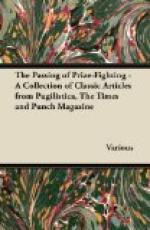Outside at last, thank goodness! The Groote Kerk, according to BOSCH, “is not vort de see,” so we don’t see it. Sandford has a sneaking impression that I ought to go in, but Merton glad to be let off. We go to see the pictures at the Mauritshuis instead. BOSCH exchanges greetings with the attendants in Dutch. “Got another of ’em in tow, you see—and collar-work, I can tell you!” would be a free translation, I suspect, of his remarks. Must say that, in a Picture-gallery, BOSCH is a superfluous luxury. He does take my ignorance just a trifle too much for granted. He might give me credit for knowing the story of ADAM and EVE, at all events! “De Sairpan gif EVA de opple, an’ EVA she gif him to ADAM,” BOSCH carefully informs me, before a “Paradise,” by RUBENS and BRUEGHEL. This rouses my Merton half to inquire what ADAM did with it. “Oh, he ead him too!” says BOSCH in perfect good faith. I do wish, too, he wouldn’t lead me up to PAUL POTTER’s “Bull,” and ask me enthusiastically if it isn’t “real meat.” I shouldn’t mind it so much if there were not several English people about, without couriers—but there are. My only revenge is (as Merton) to carefully pick out the unsigned canvases and ask BOSCH who painted them; whereupon, BOSCH endeavours furtively to make out the label on the frames, and then informs me in desperation, “it was ’School.’—yass, he baint him!” BOSCH kindly explains the subject of every picture in detail. He tells me a DROOCHSLOOT represents a “balsham pedder.” I suppose I look bewildered, for he adds—“oppen air tance mit a village.” “Hier dey vas haf a tispute; dis man say de ham vas more value as de cheese—dere is de cheese, and dere is the ham.” “Hier is an old man dot marry a yong vife, and two tevils com in, and de old man he ron avay.” “Hier he dress him in voman, and de vife is vrighten.” “Hier is JAN STEEN himself as a medicine, and he veel de yong voman’s polse and say dere is nodings de madder, and de modder ask him to trink a glass of vine.” “Hier is de beach at Skavening—now dey puild houses on de dunes—bot de beach is schdill dere.” Such are BOSCH’s valuable and instructive comments, to which, as representing Sandford and Merton, I listen with depressed docility. All the same, can’t help coming to the conclusion that Art is not BOSCH’s strong point. Shall come here again—alone. We go on to the Municipal Museum, where he shows me what he considers the treasures of the collection—a glass goblet, engraved “mit dails of tobaggo bipes,” and the pipes themselves; a painting of a rose “mit ade beople’s faces in de leafs;” and a drawing of “two pirts mit only von foots.”
Outside again. BOSCH shows me a house. “Lokeer. In dot house leef an oldt lady all mit herself and ade sairvans. She com from Friesland, yassir.” Really, I think BOSCH is going to be interesting—at last. There is a sly twinkle in his eye, denoting some story of a scandalous but infinitely humorous nature. “Well, BOSCH, go on—what about the old lady?” I ask, eagerly, as Merton. “Wol, Sir,” says BOSCH, “she nefer go noveres.” ... That’s all! “A devilish interesting story, Sumph, indeed!” to quote Mr. Wagg.




